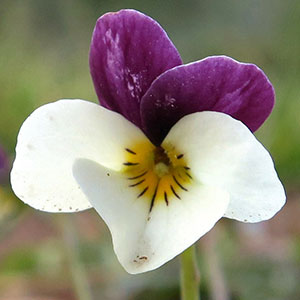Viola hallii
Viola palmata
Hall's violet, Oregon violet, wild pansy
early blue violet, three-lobe violet, three-lobed violet, trilobed violet, wood violet
1–3, decumbent or ascending to erect, ca. 1/2 subterranean, glabrous, clustered on single, short, vertical, deep-seated caudex.
basal and cauline;
basal: 1–4, palmately compound, ± 2-ternate or 3-ternate, leaflets 3;
stipules adnate to petiole, forming 2 linear-lanceolate wings, unlobed, margins entire, apex of each wing free, acute;
petiole 5–8 cm, glabrous;
blade ovate to deltate, 2.8–6 × 2.6–6.5 cm, ± coriaceous, base tapered, ultimate lobes narrowly elliptic, lanceolate, or oblanceolate, 1–7 mm wide, margins entire, ciliate or eciliate, apex acute, mucronulate, surfaces glabrous;
cauline similar to basal except: stipules usually lanceolate, sometimes broadly ovate, ± leaflike, margins toothed;
petiole 1.3–6 cm;
blade 2–4.8 × 1.2–5.5 cm.
basal, 2–3, ascending to erect;
stipules linear-lanceolate, margins entire, apex acute;
petiole 1–20 cm, glabrous or pubescent;
earliest leaf blades unlobed, mid-season blades 3–9-lobed, lobes sometimes appearing petiolate and sometimes further lobed;
earliest leaf blades reniform to ovate, mid-season blades with middle lobes usually ovate or elliptic to widely obovate, sometimes narrowly elliptic, narrowly ovate, lanceolate, or spatulate to narrowly obovate, lateral lobes elliptic, obdeltate, or spatulate to falcate, smaller lobes similar, 1–14 × 1–10 cm, base truncate to cordate, margins serrate or entire, usually ciliate, apex acute, rounded, blunt, or obtuse, surfaces glabrous or pubescent throughout or along veins.
2.5–11 cm, glabrous.
3–13 cm, glabrous or pubescent.
sepals lanceolate to ovate, margins ciliate, auricles 0.5–1 mm;
petals: upper 2 almost black abaxially, dark reddish violet adaxially, lower 3 pale yellow, cream, or ± white, lateral 2 bearded, with deep yellow to orange patch basally, dark reddish violet-veined, lowest with deep yellow to orange patch basally, dark reddish violet-veined, 5–18 mm, spur yellow, gibbous, 0.5–2 mm;
style head bearded; cleistogamous flowers absent.
sepals lanceolate, margins ciliate or eciliate, auricles 0.5–1 mm;
petals violet on both surfaces, lower 3 white basally, lower 3 and upper 2 sometimes purple-veined, lateral 2 bearded, spur sometimes bearded, lowest 15–25 mm, spur white, gibbous, 2–3 mm;
style head beardless; cleistogamous flowers on prostrate to ascending peduncles.
ellipsoid, 4–12 mm, glabrous.
ellipsoid, 5–15 mm, glabrous.
light brown, shiny, 3.2–3.5 mm.
beige, mottled to bronze, 1.5–2.5 mm.
= 60, 72.
= 54.
Viola hallii
Viola palmata
Viola hallii was discovered on the grounds of Willamette University in Salem, Oregon, by Elihu Hall, a professor at that institution (V. B. Baird 1942). Leaves of V. hallii are similar to V. beckwithii.
(Discussion copyrighted by Flora of North America; reprinted with permission.)
N. L. Gil-Ad (1997) presented evidence based on seed coat micromorphology that some plants known as Viola palmata are hybrids between plants with lobed and unlobed leaves and believed the type specimen to be hybrid in origin. He chose not to recognize the name V. palmata, choosing instead to recognize V. triloba. If the type specimen does represent a hybrid, Gil-Ad would be correct in recognizing V. triloba. Because the purity of the type specimen cannot be ascertained, we consider V. palmata the most appropriate name for this taxon. We acknowledge the presence of hybrids between lobed and unlobed plants; such hybrids obscure lines of demarcation. Some herbarium specimens may represent such hybrids; we feel most do not.
L. E. McKinney (1992) described the nomenclatural history of Viola palmata. Homophylly versus heterophylly differentiates V. palmata from V. subsinuata, the homophyllous violet most often called V. palmata. We know that the taxon described by Linnaeus was heterophyllous, with some undivided leaf blades.
Varieties 2 (2 in the flora).
(Discussion copyrighted by Flora of North America; reprinted with permission.)
1. Petioles, leaf surfaces, and peduncles usually pubescent, rarely glabrous; apex of middle leaf lobe acute; plants of dry to mesic habitats. | var. palmata |
1. Petioles, leaf surfaces, and peduncles usually glabrous, rarely pubescent; apex of middle leaf lobe rounded, blunt, or obtuse; plants of wet ground. | var. heterophylla |


